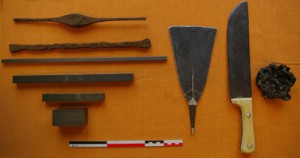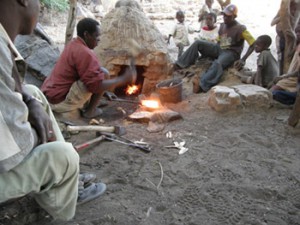
Material for traditional forge tests in Dogon Country (January 2008). Left : different kinds of iron used (ancient iron bars, modern bars with different sections). Center : a hoe and a big knife. Right : a forge slag. Photo R. Soulignac
The smiths of the villages in the Dogon Country continue to make most of the tools for daily life with traditional techniques: hoes, axes, knives, etc. The aims of this research are to describe these forging techniques and to understand the relationships between the different procedures and the resulting waste (slag and rust).
Observations made under controlled conditions permit more rigorous interpretation of the abundant forge slags found during archaeological excavations in Mali, but also applicable to Europe.
We study the different factors that influence the formation of waste: work length, temperatures reached, iron or steel working, working of raw or prepared iron, thermic treatments (soldering, reheating, tempering), specific technological actions (soldering), etc.

